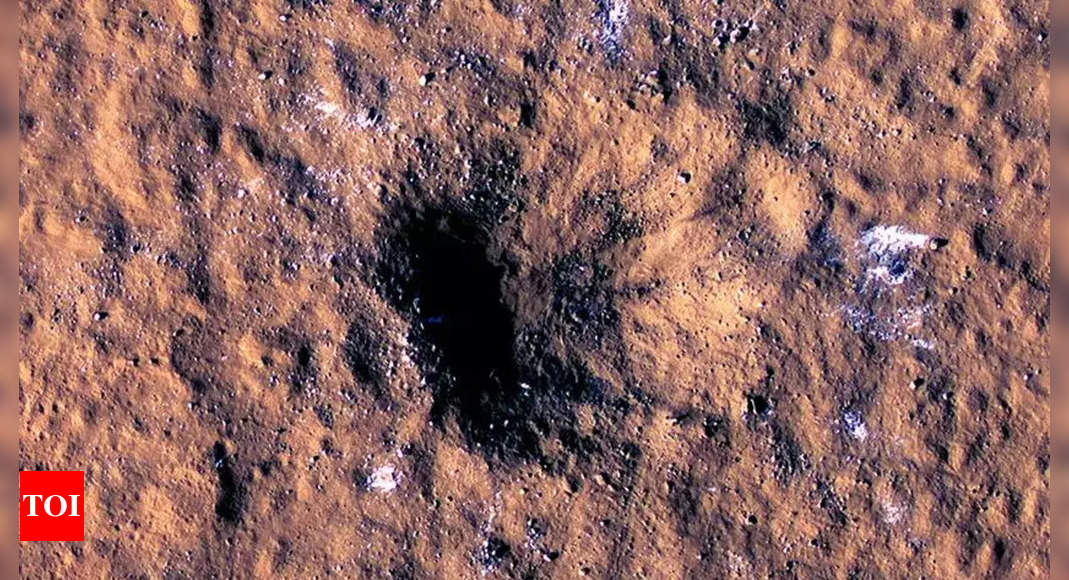WASHINGTON: A brand new research finds the unique crust on Mars is extra advanced, and advanced, than beforehand thought.
Researchers have decided the Martian crust has better concentrations of the chemical ingredient silicon, which can imply Mars’ authentic floor might have been just like Earth’s first crust.The Martian floor is uniformly basaltic, a product of billions of years of volcanism and flowing lava on the floor that finally cooled.
As a result of Mars didn’t endure full-scale floor reworking just like the shifting of continents on Earth, scientists had thought Mars’ crustal historical past was a comparatively easy story.However in a brand new research, researchers discovered areas within the Pink Planet’s southern hemisphere with better concentrations of silicon, a chemical ingredient, than what could be anticipated in a purely basaltic setting.
The silica focus had been uncovered by area rocks that slammed into Mars, excavating materials that was embedded miles beneath the floor, and revealing a hidden previous.”There’s extra silica within the composition that makes the rocks not basalt, however what we name extra advanced in composition,” says Valerie Payre, assistant professor within the Division of Earth and Environmental Sciences on the College of Iowa and the research’s corresponding writer.
“That tells us how the crust fashioned on Mars is unquestionably extra advanced than what we knew.
So, it is extra about understanding that course of, and particularly what it means for a way Earth’s crust first fashioned.”Scientists consider Mars fashioned about 4.5 billion years in the past.
Precisely how the Pink Planet got here into being is a thriller, however there are theories.
One concept is that Mars fashioned through a titanic collision of rocks in area that, with its intense warmth, spawned a completely liquefied state, also called a magma ocean.
The magma ocean progressively cooled, the speculation goes, yielding a crust, like a layer of pores and skin, that may be singularly basaltic.One other concept is that the magma ocean was not all-encompassing, and that components of the primary crust on Mars had a distinct origin, one that may present silica concentrations completely different from basaltic.Payre and her analysis companions analyzed information gathered by the Mars Reconnaissance Orbiter for the planet’s southern hemisphere, which earlier analysis had indicated was the oldest area.
The researchers discovered 9 areas — comparable to craters and fractures within the terrain — that have been wealthy in feldspar, a mineral related to lava flows which can be extra silicic than basaltic.”This was the primary clue,” Payre says.
“It’s as a result of the terrains are feldspar-rich that we explored the silica concentrations there.”Feldspar had been discovered beforehand in different areas on Mars, however additional evaluation confirmed the chemical composition in these areas was extra basaltic.
That didn’t deter the researchers, who turned to a different instrument, known as THEMIS, which might detect silica concentrations by way of infrared wavelength reflections from the Martian floor.
With information from THEMIS, the workforce decided the terrain at their chosen areas was extra silicic than basaltic.Including additional credence to their observations, meteorites comparable to Erg Chech 002, found within the Sahara and relationship roughly to the beginning of the photo voltaic system, present comparable silicic and different mineral compositions that the workforce noticed within the 9 areas on Mars.The researchers additionally dated the crust to about 4.2 billion years, which might make it the oldest crust discovered on Mars up to now.Payre says she was mildly stunned on the discovery.”There have been rovers on the floor which have noticed rocks that have been extra silicic than basaltic,” she says.
“So, there have been concepts that the crust may very well be extra silicic.
However we by no means knew, and we nonetheless do not know, how the early crust was fashioned, or how outdated it’s, so it is form of a thriller nonetheless.”Whereas Mars’ crustal origin stays shrouded, Earth’s crustal historical past is even much less clear, as any vestiges of our planet’s authentic crust have been lengthy erased because of the shifting of continental plates for billions of years.
Nonetheless, the discovering might provide insights into Earth’s origins.”We do not know our planet’s crust from the start; we do not even know when life first appeared,” Payre says.
“Many suppose the 2 may very well be associated.
So, understanding what the crust was like a very long time in the past might assist us perceive the entire evolution of our planet.”Payre carried out the analysis as a postdoctoral researcher at Northern Arizona College.
She joined the UI in August.The research, “An advanced early crust uncovered on Mars revealed by way of spectroscopy,” was printed on-line Nov.
4 within the journal Geophysical Analysis Letters..



Comment here